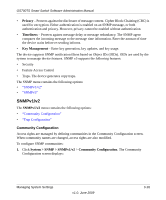Netgear GS748TS GS7xxTS User Manual - Page 48
Switching the Stacking Master, Stack Configuration and Management, Basic, Stack Configuration
 |
UPC - 606449049480
View all Netgear GS748TS manuals
Add to My Manuals
Save this manual to your list of manuals |
Page 48 highlights
GS700TS Smart Switch Software Administration Manual Switching the Stacking Master The Secondary Master replaces the Stacking Master if one of the following events occur: • The Stacking Master fails or is removed from the stack. • Links from the Stacking Master to the stacking members fails. • A soft switchover is performed via the web interface. Switching between the Stacking Master and the Secondary Master results in a limited service loss. Any dynamic tables are relearned if a failure occurs. The Running Configuration file is synchronized between the Stacking Master and the Secondary Master and continues running on the Secondary Master. Stack Configuration and Management The Stacking menu contains the following options: • "Basic" • "Advanced" Basic The Stacking Basic menu contains the following option: • "Stack Configuration" Stack Configuration The Basic Stack Configuration screen allows network managers to define the stacking master election mode. A unique Unit Number (1-6) identifies a stack member. The configuration is saved and managed by the Master unit. The stack configuration has the following default: • The stacking numbering method is set to auto-numbering. To configure Basic stacking: 1. Click System > Stacking > Basic > Stack Configuration. The Basic Stack Configuration screen displays: 3-13 v1.0, June 2009 Managing System Settings















